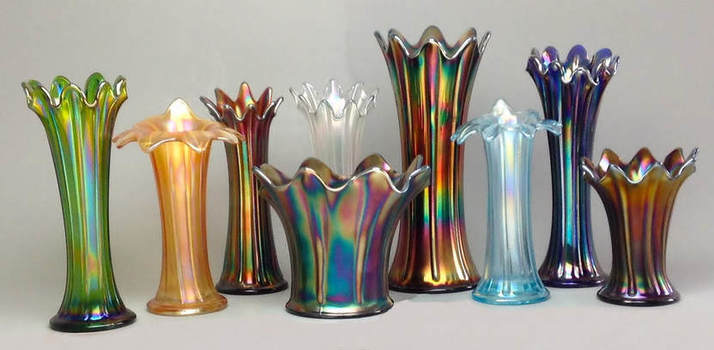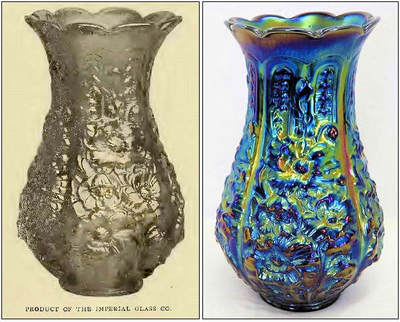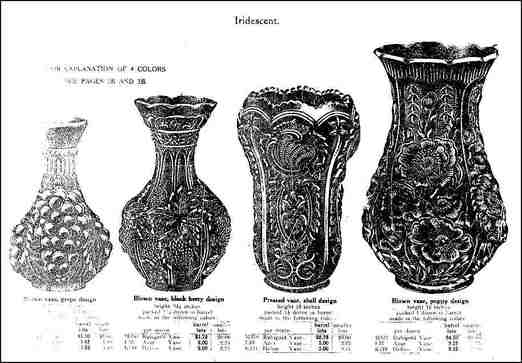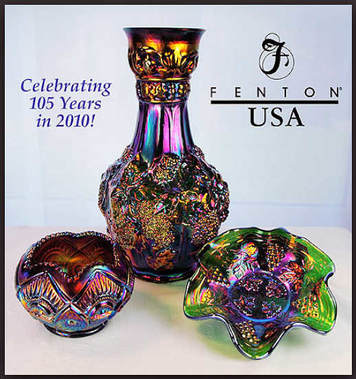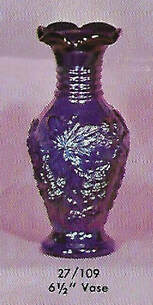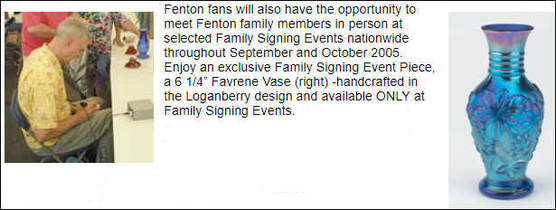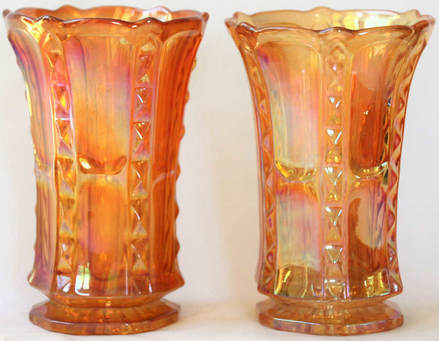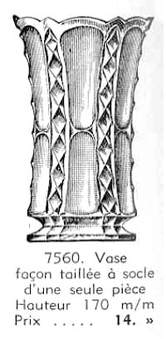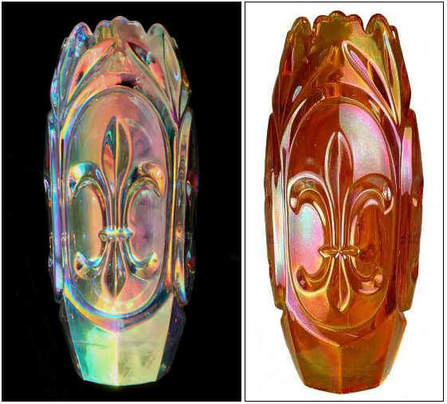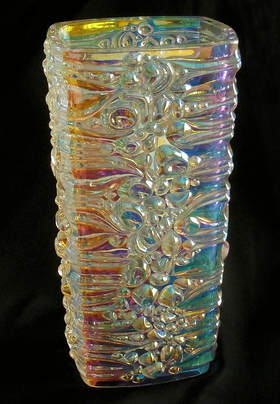NetworK ezine Issue 39. August 2018
Totally devoted to Carnival Glass
FOCUS ON VASES
Northwood Thin Rib – Joan Doty
The above photo, courtesy of the vase expert, Joan Doty, features an array of Northwood’s Thin Rib vases. Joan writes not only eloquently, but also with excellent information and incisiveness – and we are delighted to feature her superbly illustrated article about Northwood’s Thin Rib vases on our website. As Joan explains, these vases were very popular: “the first ads for the pattern appeared in 1909” and it “was still being produced in 1925 when the company folded.” Joan further observes that “multiple moulds were needed through the years to meet the demand for these vases”.
Read Joan Doty's full article with its superbly detailed, explanatory illustrations here: “Northwood Thin Rib Vases”.
Read Joan Doty's full article with its superbly detailed, explanatory illustrations here: “Northwood Thin Rib Vases”.
|
Imperial’s Poppy Show Vase
Imperial’s Poppy Show vase is a massive piece, made by blowing the hot glass into the mould – and it was clearly a favourite item as Imperial selected it for re-issue in the 1960s, apparently calling it “Poppy Delight” (with further reproductions made by Fenton for Singleton Bailey in some amazing colours). The Classic, old vase can be recognised by its scalloped top (the later vases are ruffled or otherwise shaped and are usually trademarked). But when was this Classic, old vase first made? We know it was illustrated in Imperial’s 101B catalogue (c. 1915) but could it have been introduced even earlier than that? Well, here’s the proof. The Poppy Show vase was being made by Imperial as early as 1911, as you can see in this amazing illustration (immediate right) from the Crockery and Glass Journal of that year. The Journal showed a Poppy Show vase described as "PRODUCT OF THE IMPERIAL GLASS CO." On the far right is a Classic Poppy Show vase in purple (a colour that Imperial originally called Azur). Image courtesy of Seeck Auctions. |
|
It’s interesting to see that the Poppy Show vase was described as a “Blown vase, poppy design” in the Imperial 101B catalogue that dates from around 1914 - 1915 (on the right). Alongside it were shown three more, familiar Imperial vases, and the exciting thing is, they were given descriptive names. So, do you think that the names collectors gave these vases (the pattern names we use today) were similar to Imperial's original design intentions? Let’s reveal all (left to right in the catalogue): Today’s name Imperial Grape carafe – original Imperial design, "grape" vase. Today’s name Loganberry vase – original Imperial design, "black berry". Today’s name Scroll and Flower Panels – original Imperial design, "shell". Click the ad to see all the details in the catalogue, plus lots of interesting information and photos. Be sure to click through to the second page of the article to see the catalogue image full size! |
|
And on to Fenton in 2010
In 2010, Fenton wrote in their newsletter “As we celebrate 105 years of business … we offer several new pieces in Marigold Carnival*”. One of the pieces shown on the cover (right) was what Fenton called their "Grape Vase", and as you can see, the vase is in fact Imperial's "black berry design" vase originally from 1915, the one that that collectors now call “Loganberry”. Imperial reissued this vase in Contemporary Carnival in green, white and amber, and subsequently by Imperial’s successors in pink, ice blue, ice green and purple. The reissues should be marked IG, LIG or ALIG. And now we see it being made by Fenton and called a “Grape Vase". It appears to have been made using the earlier Imperial mould, but the neck section has been re-styled in a very different way to the Classic original, and of course, it will be marked with Fenton’s oval cartouche and the letter F. The other two pieces on the newsletter cover are a rose bowl on the left - this is a version of Imperial’s Twins pattern - and on the right is what seems to be a Grape and Cable patterned bowl. * And to add a little confusion - what Fenton called "Marigold" in their Contemporary/reissued Carnival was actually "a combination of marigold iridescence on dark base glass, producing a breathtakingly, vibrant iridescence". They referred to their Contemporary glass with a marigold base glass colour as "Orange Carnival". |
The Loganberry Story continues …
|
Above: the small Loganberry vase in Aurora Jewels,
as shown in Imperial’s 1970 catalogue supplement. |
There’s also another vase called Loganberry, but it’s smaller … much smaller and slimmer than the original Loganberry ... so it is easy to identify it.
This appears to have been a new mould for Imperial when they issued it in their Aurora Jewels collection in 1970. Standing 6½ inches high, it was also made in white and pink by Lennox Imperial in the 1970s. More recently, in 2005, it was made by Fenton in Favrene, and was available only at the Fenton Family Signing events. Fenton's Loganberry vase in Favrene at a Family Signing Event.
|
Rudolf by Inwald
We’ll cross the Atlantic and visit Europe now, and turn the clock back to the late 1920s, when these beautiful vases shown below, were introduced into the repertoire of the famed glass-maker, Inwald, in Czechoslovakia.
We’ll cross the Atlantic and visit Europe now, and turn the clock back to the late 1920s, when these beautiful vases shown below, were introduced into the repertoire of the famed glass-maker, Inwald, in Czechoslovakia.
This pair of superbly iridised vases were recently discovered and have been named “Rudolf” by the finder, in honour of the Inwald master-designer, Rudolf Schroter. Standing around 7 inches high, these vases are the first known in this beautiful pattern. The shimmering iridescence is typical of the astonishing pastel marigold that characterises the very best of Inwald’s Carnival.
The detail in the moulded design can be seen well in the catalogue illustration on the right.
The detail in the moulded design can be seen well in the catalogue illustration on the right.
Sklo Union Vases
On the left (below) is an amazing 10 inch high Fleur de Lys vase. It was made in the c.1970s at Hermanova Hut (part of the Sklo Union Group in the Czech Republic). We believe that these vases were mostly made in clear glass, but some exceptionally scarce examples were iridised, like the one shown. The iridescence appears to be stannous chloride; it has a glorious multi-coloured iridescence with an astonishingly beautiful, shimmering pastel effect. This is the only Carnival example of the Fleur de Lys vase from Hermanova Hut we are aware of.
Shown to its right is our 10 inch Fleur de Lys vase in marigold which is a piece of early Classic Carnival made in Czechoslovakia by Inwald. The two vases are identical in shape, size and mould detail, leading us to believe that Hermanova Hut was using the original Inwald mould. The base is interesting! The older Inwald items have a polished, mirror-ground base, whereas the later Hermanova Hut vase is more coarsely ground, and not polished.
Shown to its right is our 10 inch Fleur de Lys vase in marigold which is a piece of early Classic Carnival made in Czechoslovakia by Inwald. The two vases are identical in shape, size and mould detail, leading us to believe that Hermanova Hut was using the original Inwald mould. The base is interesting! The older Inwald items have a polished, mirror-ground base, whereas the later Hermanova Hut vase is more coarsely ground, and not polished.
Meet "Lila"
We’ll close this August issue of NetworK with another magnificent and fabulously iridised Sklo Union vase. The design for this vase was created in 1971 by the renowned glass artist Frantisek Peceny. This vase was called “Lila” and is reported to have been made at both Libochovice and Hermanova Hut. The vase was one of several exhibited at a major pressed glass exhibition in 1972. The vase shown above, right, is a massive item. It also stands 10 inches high and it weighs 5 pounds (2.25 kilos).
We have built up a huge amount of information about Carnival Glass vases. Below are two links that will take you to our main menu page for vases, and our A-Z Vase index of around 200 vases that are on the website. A link from the Main Menu page will take you to a special picture gallery where there are more of these spectacular Sklo Union vases on show.
Vase Main Menu: Carnival Glass Vases
Vase Index: A-Z Vase Pattern Index
We’ll close this August issue of NetworK with another magnificent and fabulously iridised Sklo Union vase. The design for this vase was created in 1971 by the renowned glass artist Frantisek Peceny. This vase was called “Lila” and is reported to have been made at both Libochovice and Hermanova Hut. The vase was one of several exhibited at a major pressed glass exhibition in 1972. The vase shown above, right, is a massive item. It also stands 10 inches high and it weighs 5 pounds (2.25 kilos).
We have built up a huge amount of information about Carnival Glass vases. Below are two links that will take you to our main menu page for vases, and our A-Z Vase index of around 200 vases that are on the website. A link from the Main Menu page will take you to a special picture gallery where there are more of these spectacular Sklo Union vases on show.
Vase Main Menu: Carnival Glass Vases
Vase Index: A-Z Vase Pattern Index
A big "Thank You!" from NetworK
Why not join in the fun, and maybe also invite your friends to join us all here: NetworK's very active Facebook Group.
Privacy and the use of your information: we only use your name and email address to send you your FREE Carnival Glass NetworK ezine. We will not share your name or email address with anyone else, or use it for any other purpose. You can change your mind about receiving your NetworK ezine at any time by clicking the unsubscribe link at the foot of every issue, or by emailing us at [email protected]
Join us on Facebook
We invite you and your friends to join us all on NetworK's fast growing and very active Facebook Group (link is below), and if you have missed any of the previous issues of NetworK and NetworK Specials, they are all here: Back Issues.
We invite you and your friends to join us all on NetworK's fast growing and very active Facebook Group (link is below), and if you have missed any of the previous issues of NetworK and NetworK Specials, they are all here: Back Issues.

